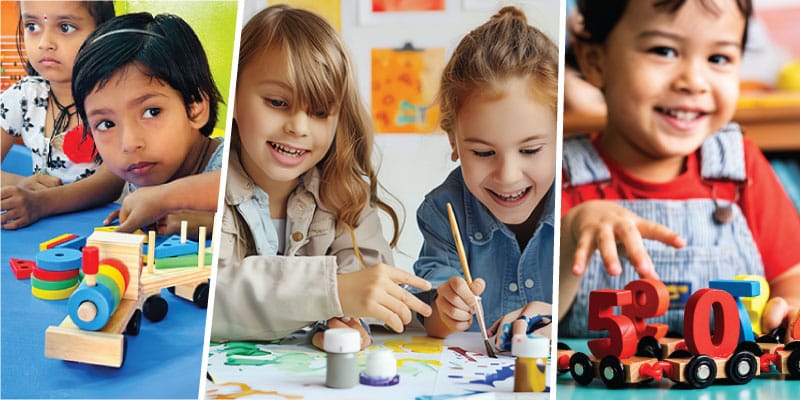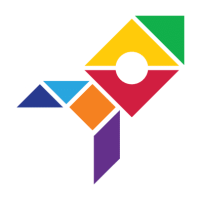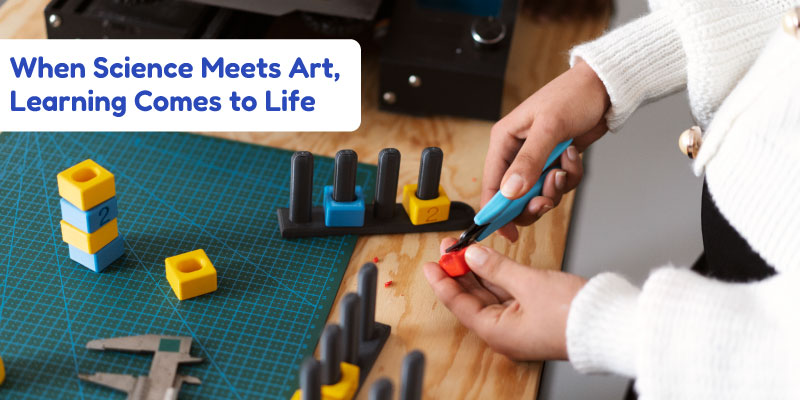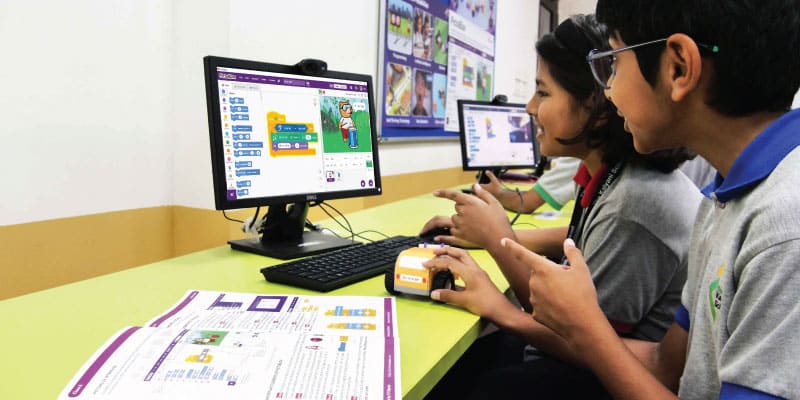In the critical years of early education, the challenge is clear: how do we move beyond rote learning to foster holistic development and lifelong learning? NEP 2020, supported by the NIPUN Bharat Mission, emphasises achieving Foundational Literacy and Numeracy (FLN) through play-based and activity-based pedagogy. The key to this transformation lies in carefully chosen Teaching Learning Materials (TLMs) that turn passive instruction into joyful, hands-on exploration.
Drawing inspiration from approaches like Reggio Emilia, which embrace the “100 languages of children”, TLMs allow children to express themselves through art, movement, music, and sensory play. Aligned with Edgar Dale’s Cone of Experience, active engagement through TLMs enhances retention and sparks curiosity.
This blog explores five impactful categories of TLMs that bring together traditional wisdom and modern innovation, helping classrooms embody the 3H philosophy – Hands, Heart, and Head – and create child-centric, experiential learning spaces.
Teaching Learning Materials and Their Alignment with NEP 2020 and FLN Goals
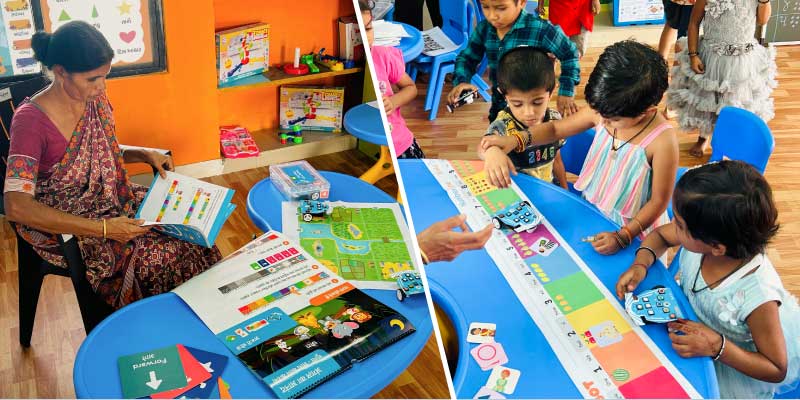
Anchoring TLMs in Policy by the NEP 2020 Mandate
These tools are chosen to foster holistic child development by letting children “do” and “experience ” their learning in multiple “languages”; these serve as cornerstones for the NEP 2020 Foundational Stage. The design and integration of these diverse TLMs are rooted in a broader vision of the National Educational Policy (NEP) 2020. The principles for using them are clearly outlined in key chapters.
- Chapter 1 (Early Childhood Care and Education): This chapter highlights the importance of engaging learning environments, supporting the idea of play-based and experiential learning that these TLMs represent.
- Chapter 4 (Curriculum and Pedagogy): This section offers clear guidance on moving towards holistic, inquiry-based, and discovery-oriented learning. These materials help achieve this during the foundational stage.
- Chapter 21 (Multilingualism): The focus on language diversity and mother-tongue instruction, essential for effective language learning, is a key point here.
- Chapter 23 (Technology Integration): This chapter promotes the careful use of digital tools and the development of smart classrooms. It confirms the role of electronic TLMs in modern education.
This strong policy framework shows that these TLMs are not just resources but are vital to reaching the NEP’s main goals for foundational literacy and numeracy and overall child development within the Indian education system.
Now, let’s take a closer look at our top 5 teaching and learning materials.
1. Montessori Teaching Learning Material: A Sensory Exploration and Cognitive Skill Beginning
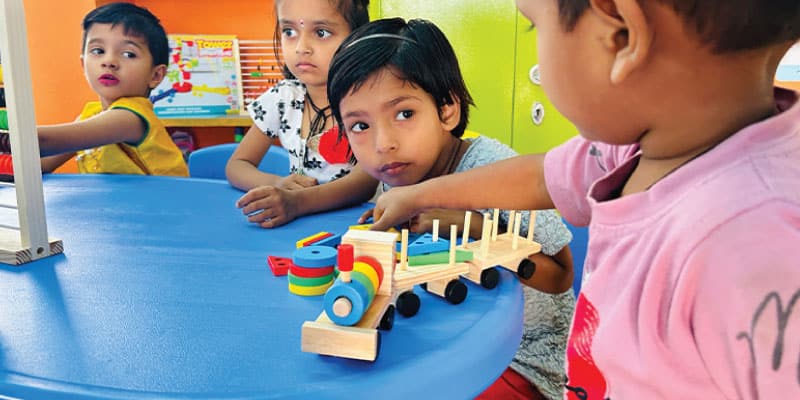
The foundation of a child’s learning journey often starts with sensory play and motor development. Montessori toys play a key role here, as Montessori TLMs.
Purposeful Design and Engagement
Picture little hands reaching for smooth wooden blocks, sorting colourful shapes, or carefully threading beads. These Montessori learning materials, made from natural materials, promote calmness and focused attention. They aren’t just toys; they are carefully designed tools for cognitive and physical growth. They offer many Montessori activities that support self-correction and deep involvement, fostering play-based learning at its best.
Facilitating Holistic Development
By engaging in this hands-on play, children develop essential fine motor skills while also understanding abstract concepts such as pattern recognition and spatial awareness. This direct interaction helps them perform hands-on learning of these concepts, allowing them to move up Dale’s Cone of Experience. The process of self-correction and discovery in places like anganwadis and pre-primary education lays a strong foundation. It fosters independence, problem-solving skills (a key aspect of critical thinking in early childhood), and an inherent curiosity that we hope will grow throughout their lives, underscoring the benefits of TLMs in early education for children’s creativity and holistic growth.
Montessori materials are organised to support development across various areas:
- Practical Life Materials: These involve scaled-down everyday activities like pouring, scooping, buttoning frames, or sweeping. They help build concentration, coordination, and independence.
- Sensorial Materials: Designed to refine the five senses, these include the Pink Tower (for dimension), the Broad Stair (for width), Colour Tablets (for visual discrimination), and Smelling Bottles (for the sense of smell).
- Language Materials: These tools support spoken and written language development, including the Sandpaper Letter (for phonetic awareness), the Movable Alphabet (for early word-building), and structured reading activities.
- Mathematics Materials: These are tangible representations of math concepts, including number rods, spindle boxes, and the golden beads for understanding quantity and operations.
- Cultural and Cosmic Education Materials: These resources allow exploration of geography (e.g., puzzle maps), history, and science through hands-on activities.
2. Smart Electronic Devices For Innovative Learning

In today’s technology-driven world, it is essential to assess children’s screen exposure thoughtfully. When used thoughtfully, electronic devices can significantly broaden a child’s early learning opportunities, bringing the world to their doorstep.
These kind of tools also promotes digital literacy in the classroom. Incorporating digital tools and resources into the curriculum offers several benefits, such as enhanced engagement, improved retention, personalised learning experiences, and collaboration opportunities.
For more details on promoting digital literacy in the classroom, read the blog HERE.
Bridging the Classroom to the World
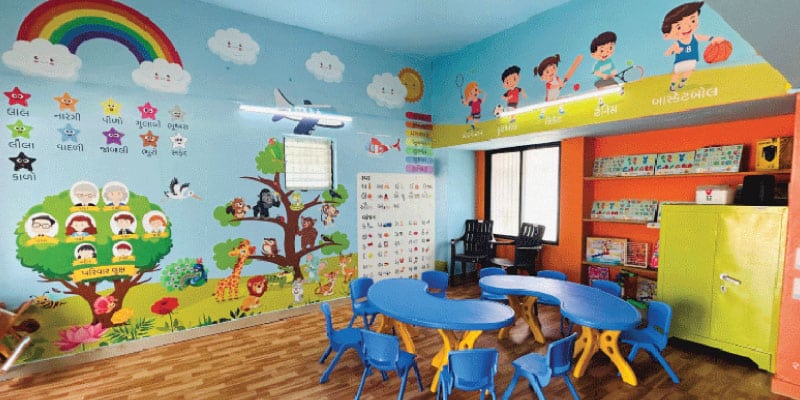
Consider a smart LED TV displaying a colourful nutrition chart, or tablets providing interactive content. For instance, in our Vadodara Smart Anganwadi’s, ‘Maro Happy Time’ initiative utilises these brilliant LED TVs to display engaging ‘Maro Health Corner’ charts for the students, providing them with a dynamic and accessible way to learn about healthy living. In a classroom with diverse learning styles, these aids serve as effective audiovisual teaching and learning materials and interactive learning tools.
Dynamic Engagement and Learning Materials
- These tools mediate visual storytelling, making complex ideas and distant realities immediately engaging for diverse learners.
- They enable ‘real-life simulations,’ allowing students to observe scenarios such as a busy marketplace or the wonders of nature that might otherwise be out of reach.
- The combination of motion and sound from a microphone with a speaker system provides strong reinforcement, which is constructive for visual and auditory learners.
- For classrooms supported by Samagra Shiksha Abhiyan or Smart TV-aided early childhood education rooms, these devices ensure equal access to high-quality, engaging content.
- Additionally, specialised materials like ‘Flash Cards with AR applications in regional languages’ increase engagement and make learning culturally relevant, turning passive viewing into truly immersive experiences.
The advantages of teaching learning materials in early education, particularly digital ones, lie in their ability to scale and reach children effectively.
3. Wizbot, An Educational Screen-Free Toy For Young Children Aged 4-10
As children grow, they become curious about how things work and how cause leads to effect. While formal coding for young children may seem far off, Wizbot, a screen-free educational robotics toy for FLN and CT education, provides a clever solution. Designed for children ages 4 to 8, Wizbot presents abstract ideas in logic and algorithms in a fun, hands-on way, enhancing their classroom experience. The best part is that it’s screen-free. The excitement of a child pressing a sequence of buttons and watching their bot move just as they envisioned is perfect for sparking early interest in STEM, engaging their hands, minds, and emotions.

Engaging Hands, Head, and Heart through Wizbot
Wizbot effectively engages a child’s hands, head, and heart simultaneously.
- Hands: Children physically interact with Wizbot by pressing buttons, using coding cards, dice, or accessories such as the claw. They can even use the draw mode in Wizbot to draw shapes and patterns, turning abstract commands into real locomotion.
- Head: This physical interaction boosts cognitive development. Children grow their computational thinking through logic, directionality, spatial awareness, and early algorithmic thinking as they plan Wizbot’s movements. They are constantly developing critical thinking and problem-solving skills.
- Heart: The immediate feedback from Wizbot’s movement gives a sense of achievement and happiness. When children work together to solve challenges, it supports their social-emotional growth and sparks a love of learning and a positive connection to it.
Play-Based Pedagogy in Action
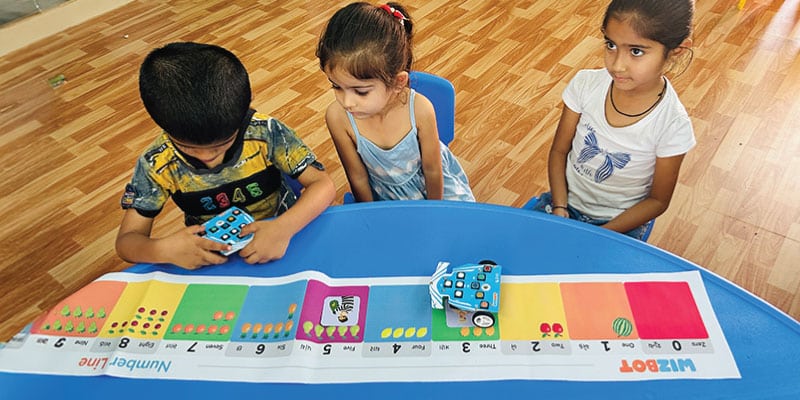
- Wizbot uses toy-based pedagogy, and children participate in activity-based learning as they guide Wizbot through exciting arenas like the Number Line, Grid, and Land using physical coding cards, picture cards, and learning materials such as dice and a claw.
- This isn’t just fun; it helps them develop computational thinking through logic, direction, and spatial awareness, as well as early algorithmic thinking.
- As they complete structured activities using the teaching and learning materials provided by Wizbot, they continuously build critical thinking, creativity, and collaborative skills.
- This experiential learning elevates them through the highest levels of the cone of experience, nurturing 21st-century skills essential for foundational literacy and numeracy.
- It makes thinking exciting for all children.
This is play-based learning at its most effective, directly supporting the NIPUN Bharat Mission and showcasing innovative teaching methods for primary schools.
4. Art Supplies For Holistic Development as a Means of Self-Expression

Sometimes, the simplest tools unlock the deepest forms of expression. Crayons, paint, clay, child-safe scissors, and a variety of recycled craft materials are the first connections the child makes with creativity. These are fundamental to early learning and cognition.
Igniting Creativity and Self-Expression
- Witnessing a child’s intense focus as they squish clay or make bold strokes with a paintbrush shows their inner world taking shape.
- These means of self-expression involve imagining, imitating, and thinking symbolically, leading them to express themselves through language and behaviour.
- These modes of self-expression foster imagination, imitation, and symbolic thought, resulting in linguistic and behavioural expression.
Fostering Holistic Development and Experiential learning
- Engaging with art supplies is deeply kinesthetic and expressive. This hands-on process promotes motor skill development, from fine motor control needed for precise drawing to the broader (gross) movements involved in creating a large artwork.
- These activities improve hand strength, dexterity, and hand-eye coordination, thereby helping them develop writing skills over time.
More importantly, integrating art into learning provides a powerful way to foster emotional expression in childhood and imaginative thinking. It allows children to share their feelings, ideas, and experiences that words might not express. The role of art in early learning is vital, as it aligns with story-based and cultural narratives, making abstract concepts more transparent and memorable. When children create through art, they reach higher levels of the Cone of Experience, building confidence and fostering innovative thinking. This makes the entire space a strong indicator of joyful self-expression and child development.
5. Language Learning Tools That Build Communication Skills in Early Learners
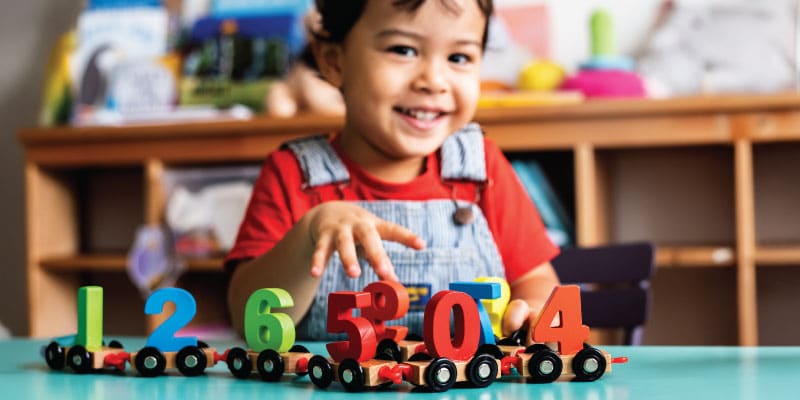
The NIPUN Bharat Mission for the universal acquisition of Foundational Literacy and Numeracy (FLN) is closely impacted through these Language Learning tools. These dedicated language-teaching tools make the classroom experience effective and enjoyable.
- Tools like Letter Land (Alphabet train), sets of engaging children’s books, the essence behind ‘Mara Vaahla Pustako!’ multilingual flashcards, interactive story dice that inspire imaginative stories, and lively phonics charts make learning more conducive and help students become lifelong learners.
- Other materials, such as puzzles, world-building games, magnetic letters, and themed visual charts (e.g., numeric trains), further support early literacy and essential numeracy concepts.
These interactive learning tools are vital for early literacy. They help build vocabulary in early childhood, lay a foundation for early reading skills, and improve comprehension. What makes them powerful is their inclusion of regional languages. By incorporating children’s native language — Hindi, Tamil, Telugu, or any other language — these aids make learning culturally relevant, prevent disengagement, and strengthen a child’s sense of identity.
The confidence or enthusiasm in a child’s voice as they pronounce a word in their mother tongue, supported by fun activity sheets, shifts learning from passive listening to active participation, making language acquisition an actual, experiential and innovative path. This focus on activity-based learning makes language vibrant and dynamic, significantly contributing to overall child development.
In a Nutshell
We have explored five impact-driven Teaching and Learning Materials. These highlight the variety of ways children learn and help them climb Edgar Dale’s Cone of Experience through active engagement that engages their hands, heads, and hearts.
These TLMs are essential parts of a holistic education system. This approach is changing pre-primary education in India and offers solutions for FLN challenges in our country. These tools and aids celebrate children’s 100 languages and lay a joyful foundation for lifelong learning and computational thinking in early childhood.

